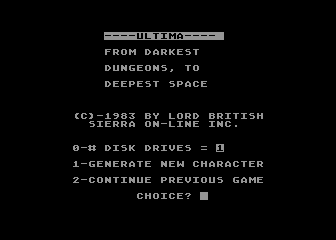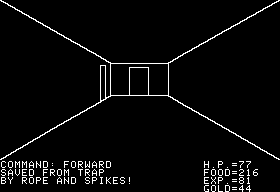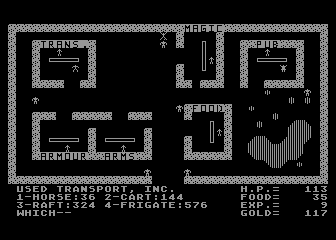Retro Replay Review
Gameplay
Ultima’s gameplay is a rich tapestry of exploration, combat, and progression that laid the foundation for modern role-playing games. You take control of the Stranger, a lone hero on a quest to travel through time, battle fearsome monsters, and ultimately thwart the immortal wizard Mondain. From the outset, the game immerses you in a tile-based world map—each step reveals new terrain, hidden dungeons, and bustling towns where you can rest, trade, and gather information.
(HEY YOU!! We hope you enjoy! We try not to run ads. So basically, this is a very expensive hobby running this site. Please consider joining us for updates, forums, and more. Network w/ us to make some cash or friends while retro gaming, and you can win some free retro games for posting. Okay, carry on 👍)
Combat in Ultima strikes a balance between strategic planning and real-time decision-making. On the world map and in towns, you navigate in a bird’s-eye view, carefully weighing when to engage wandering creatures. Once you enter dungeons, the perspective shifts to a 3D vector-line view, adding tension as you probe each corridor for lurking dangers. Every monster encounter presents a choice: attack with your drawn sword, cast a spell if you’ve acquired magical abilities, or retreat to shore up your resources.
Character progression is intuitive yet satisfying. Victory over monsters rewards experience points, allowing your hero to level up and improve attributes such as strength, dexterity, and endurance. Equally important is resource management—food and equipment must be purchased in towns, and careless adventuring can leave you stranded without supplies. This loop of exploration, combat, and resource replenishment feels rewarding and encourages careful planning on every journey.
What truly distinguishes Ultima’s gameplay, however, is its willingness to blend genres. Beyond traditional medieval fantasy, you’ll encounter sci-fi elements, including a few surprise space combat sequences that inject variety into the experience. Piloting a small spacecraft against enemy vessels may feel unexpected in a fantasy setting, but it reinforces the game’s overarching theme of time-travel and genre fusion.
Graphics
For its time, Ultima pushed graphical capabilities forward with a clear advancement over its predecessor, Akalabeth. The world map uses a tile-based system with colorful, detailed sprites representing the diverse landscapes of Sosaria—lush forests, arid deserts, and winding rivers come to life under your cursor. Moving through towns feels vibrant, as NPCs, merchants, and guard patrols animate the cobblestone streets.
The transition to 3D vector-line dungeons was a bold choice in 1981, offering a rudimentary but effective first-person experience. While the corridors and walls are drawn with simple lines, the geometry feels immersive. Shadows and shifting angles convey an ominous atmosphere, heightening the suspense as you search for keys, doors, and hidden chambers. Despite the minimalistic style, your mind fills in the details, making every step forward a leap into the unknown.
Space combat segments also employ vector graphics, this time to depict starfields and enemy ships in motion. The simplicity of lines and glowing points of light can’t compete with modern visuals, but they evoke a sense of nostalgia and wonder that few contemporary titles can replicate. These sequences serve as a reminder that Ultima was not afraid to experiment, incorporating cutting-edge graphical ideas into a largely fantasy-driven world.
Overall, while Ultima’s visuals may appear quaint today, they are impressively functional and stylistically consistent. The sprite art on the overworld captures essential details, the dungeon mazes invoke genuine tension, and the vector segments feel futuristic—all combining to create a cohesive aesthetic that still charms players who value retro authenticity.
Story
The narrative of Ultima is deceptively simple yet deeply engaging. Over a thousand years ago, the malevolent wizard Mondain crafted an evil gem that rendered him both immortal and invincible. His tyrannical rule plunged the land of Sosaria into darkness, and only by traveling back in time can the wizard’s reign be ended. This time-travel premise lends the story a grandeur often missing from early RPGs.
You embody the Stranger, an everyman hero whose destiny unfolds through exploration and discovery. There are no grand-cutscenes—story beats emerge organically via item descriptions, scrolls found in dungeons, and conversations with townsfolk. Each clue you uncover about the time machine’s whereabouts feels earned, fostering a genuine sense of accomplishment when you finally activate the temporal device and journey into the past.
The blending of medieval fantasy with sci-fi underscores the narrative’s ambition. As you leap between eras, you witness the birth of Mondain’s evil gem and confront the wizard before he secures his ultimate power. This allows you to experience two distinct versions of Sosaria—one ravaged by dark magic, the other vibrant and full of potential—giving weight to your actions and reinforcing the high stakes of your quest.
Moreover, Ultima’s story resonates because it empowers the player to feel as though they’re shaping history. The final confrontation with Mondain is less about spectacle and more about the culmination of every choice you’ve made. Destroying the gem feels symbolic of overcoming adversity and rewriting fate, making the narrative payoff emotionally satisfying even decades after the game’s original release.
Overall Experience
Playing Ultima today is like uncovering a seminal artifact from the early days of gaming. Its pioneering design, from the open world map to the hybrid dungeon system, set standards that countless RPGs would follow. While modern gamers might balk at the primitive graphics or steep learning curve, those willing to embrace its old-school sensibilities will find a rewarding adventure that demands curiosity and perseverance.
Ultima’s world feels alive in a way that transcends raw technical power. Towns bustle with merchants hawking their wares, dungeons ooze mystery, and time-travel segments ignite your imagination. The game invites you to think strategically about every encounter and to treasure each triumphant moment of leveling up or discovering a hidden chamber. In this sense, Ultima succeeds not because it holds your hand, but because it trusts you to chart your own path.
Perhaps the most enduring aspect of Ultima is its legacy. By synthesizing medieval fantasy with sci-fi, offering a seamless blend of overworld exploration and first-person dungeon crawling, and weaving a time-bending narrative, it proved that video games could tell complex stories and deliver multifaceted gameplay. For enthusiasts of gaming history or lovers of challenging RPGs, Ultima remains an essential experience—one that rewards patience, curiosity, and a sense of adventure.
In the annals of gaming, few titles can claim the influence or charm of Ultima. Whether you’re a retro gamer seeking the origins of your favorite genre or a newcomer curious about the roots of RPG storytelling, this classic offers boundless opportunities for discovery and delight. Sosaria awaits—take up your sword, gather your wits, and embark on a journey through time to save the world.
 Retro Replay Retro Replay gaming reviews, news, emulation, geek stuff and more!
Retro Replay Retro Replay gaming reviews, news, emulation, geek stuff and more!









Reviews
There are no reviews yet.